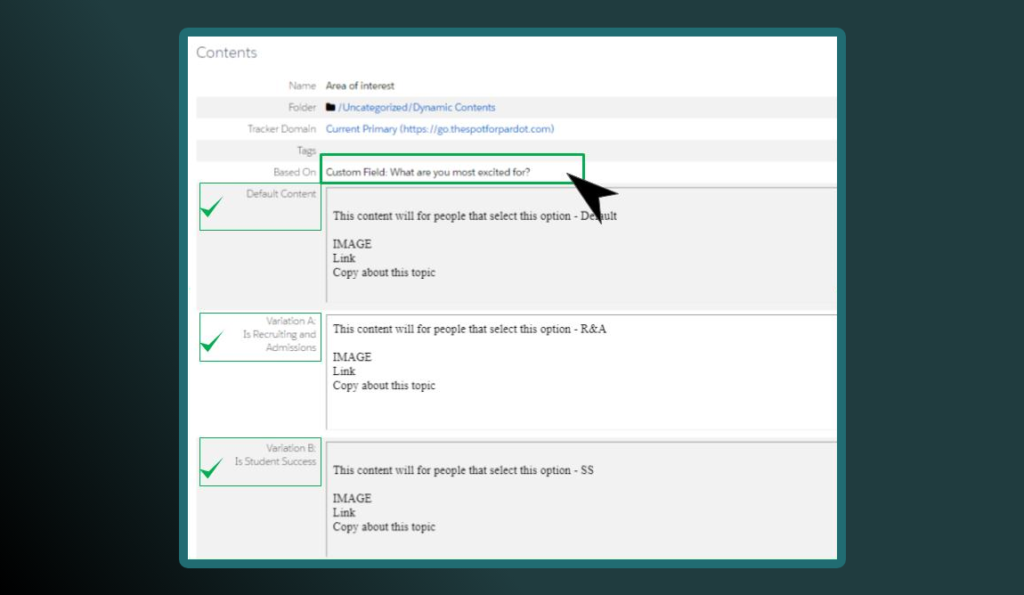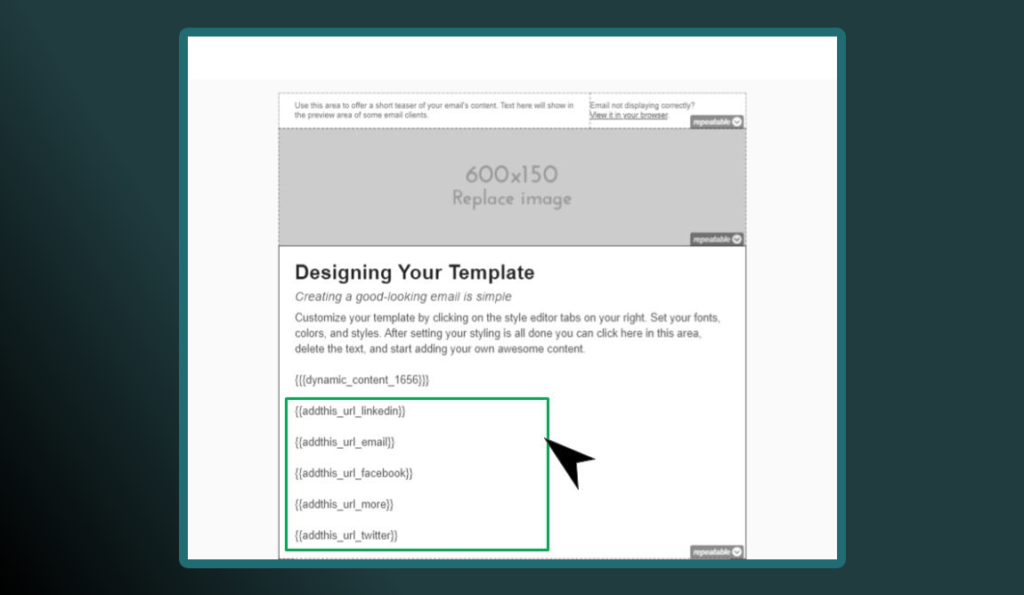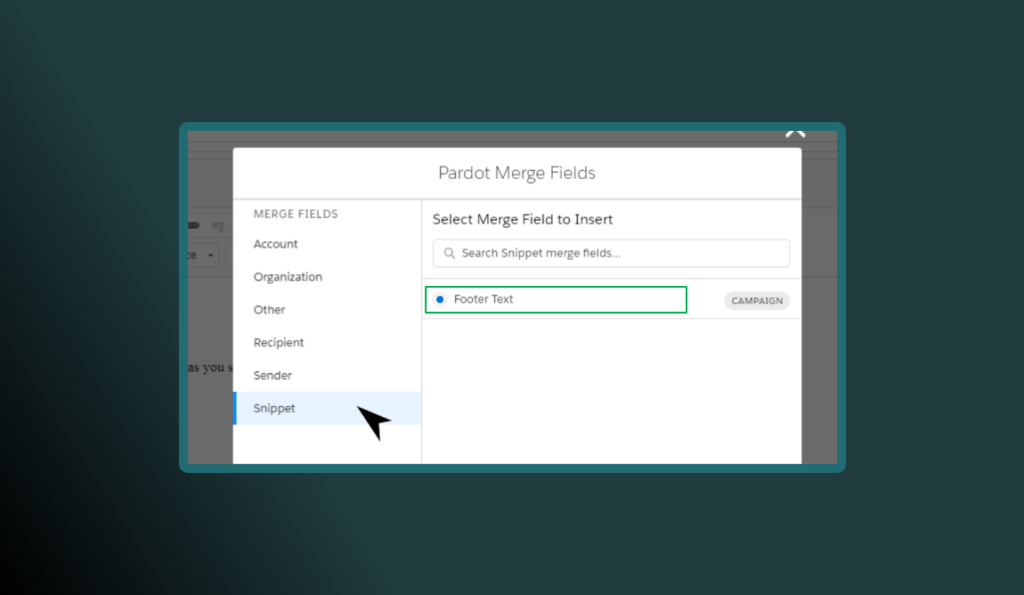Prospects now more than ever are demanding personalized content. For the last 4 years, adding the first name for personalization in emails has been the default. Unfortunately, that alone isn’t going to cut it anymore. To keep their attention, you have to make sure they know you’re thinking of them— no matter how long your list becomes.
In Pardot, the options to provide these experiences differ depending on your account tier and how you intend to use them.
If you’re a veteran to Pardot, it’s likely you know that there are several ways to accomplish the personalization you need. That’s why we’ve broken down some of the most common use cases that call for Pardot HML, Pardot Snippets, or Pardot Dynamic Content. Understanding how each of these work best in different scenarios will help you save time in your creation process.
Content personalization using Dynamic Content

Dynamic content allows you to display custom content, via Javascript, on your company’s website or within Pardot. Think about displaying different content on forms, landing pages, layout templates, and emails based on prospect criteria.
When a prospect matches the criteria for your dynamic content, the content variation corresponding to that field value will display. With this feature, it is possible to display up to 25 variations of content. If there are no matches or that person has no data, then they see the default option.
The instant benefit is that you can use one email template to showcase different pieces of content per Dynamic Content block. This feature is available both in Pardot Classic and Lightning that have a Plus or higher edition.
Popular Use Case: Showing different images or text based on the values found in the country field within an email. See our post about use cases for Dynamic Content here.
Content personalization using Handlebar Merge Language (HML)

HML is a new merge language for personalizing email in Pardot. Basically it’s the representation of a field value that you can showcase anywhere you have access to the WYSIWYG editor. Think of displaying prospects data on landing pages, forms, emails, etc. based on the data found within a prospects record in Pardot.
The benefits of Pardot HML almost immediate:
- Easy to upgrade your content.
- Ability to search for the fields you need.
- The same language is shared across Salesforce Lightning Templates, laying the foundation for more email compatibility down the road.
- HML can also be used within Dynamic Content, but not Snippets.
- Allows you to do IF/ELSE statements to further expand its uses.
- HML is available across all editions of Pardot Classic and Lightning (if enabled).
How do you know you’re using HML?
The easiest way to know is to look at your tokens. Do they look like this %%first_name%% or like this {{Recipient.FirstName}}? The option with the curly brackets ({}) is the appropriate one. New accounts from 2020 (or more recent) should have HML activated already, however, if you have an older account and need help migrating over from PML to HML, just follow our guide.
Popular Use Case: Updating email signatures for both sales and marketing emails to quickly create a connection with prospects based on CRM ownership. We also wrote about use cases for HML here.
Content personalization using Pardot Snippets

A Snippet is a reusable block of text, date, or links that can be pulled into multiple Pardot emails, forms and landing pages. These blocks are static, meaning you select the one you want and the values don’t change unless you change them. They’re best for strict text purposes as they do not support HTML/CSS.
Snippets cannot be used with Dynamic Content. However, you can insert HML into Snippets, you just have to do it manually because there’s no HML option in the Snippet wizard. You must have Connected Campaigns and HML enabled to use them within your instance.
Snippets are based on Business Unit or Campaign ownership. Although you can use Snippets in Pardot Classic, you cannot create them without access to Salesforce (Pardot Lightning is preferred if you intend to use this feature). Snippets are available for all versions of Pardot.
Popular Use Case: Updating event or footer information across multiple assets. We recently wrote about Snippets and answered a few frequently asked questions on this blog!
Comparing HML, Snippets, and Dynamic Content
The bottom line is that people don’t want to go through a million forms. They want personalized content and they want it now.
This begs the question, when is it appropriate to use each Pardot personalization feature? If you have used Pardot for a while , you know that Pardot allows you to do similar things in several different ways. To help the decision making process, we put together this chart to help you decide when to choose each of these options.
| Dynamic Content – Used for personalizing different variations of content blocks based on prospect record information | Handlebar Mail Language (HML) – Used as values from a prospect record for personalizing content across assets | Snippets – Used to personalize assets with static content. | |
| Pardot Lightning required | No | No | Yes |
| Available in All Pardot Tiers | No | Yes | Yes |
| Created/updated in Salesforce | No | Yes | Yes |
| Association to a Salesforce campaign | No | No | Yes, or Business Unit |
| Created/Updated in Pardot | Yes | Yes | No |
| Limited by Pardot Tier | Yes, Plus tier or higher | No | No |
| Updated by changes to Pardot-Salesforce data | Yes | Yes | No |
| Allows HTML/CSS for customizing content | Yes | No | No |
| Used to personalize Pardot forms | Yes | Yes, content regions only | Yes, content regions only |
| Cross Business Unit Support | No | Yes | Yes |
Example Use Cases for Pardot Personalization
Below are some scenarios you may find useful to differentiate between uses.
Scenario: You need to set up a completion action on a form that sends out an autoresponder email with specific content based on a picklist option for a field called “Area of Interest”. The picklist field on the form has four options. You don’t want to build multiple email templates. You are on the Plus edition of Pardot.
Solution: Dynamic Content shows specific content in relation to the data on the record of the prospect. This would allow you to use one email template but showcase different content based on which option the prospect chose while completing the form.
Scenario: You need to send a prospect an email receipt of the information they just submitted via a form or form handler to confirm their participation in your program. You are on the Growth edition of Pardot.
Solution: HML only shows what lies within the record of a prospect, nothing more, nothing less. You can customize the rows and order of the data in the email template to look however you want.
Scenario: Your team needs to be able to update and use a content block (with webinar information) across multiple Business Units. The information for this comes from the field marketing team and they do not have access to Pardot.
Solution: Snippets show information that is static that can be shared across different business units or locked down by campaigns. Snippets can be updated by Flows or manually by a person with the right permissions within Salesforce.
Personalization and delivering value are key to moving prospects quickly through the pipeline. Pardot provides you with a variety of features to allow you to leverage the data you already have in your CRM to your benefit.
Are you looking for ways to take your email marketing strategy to the next level with Pardot? With the guidance of our strategists, we can help you identify the fields which are and aren’t actively used by your team — it could be key to qualifying leads faster!
If you are ready to maximize your use of Pardot, give us a shout!











